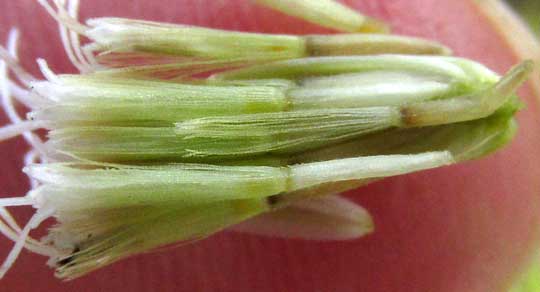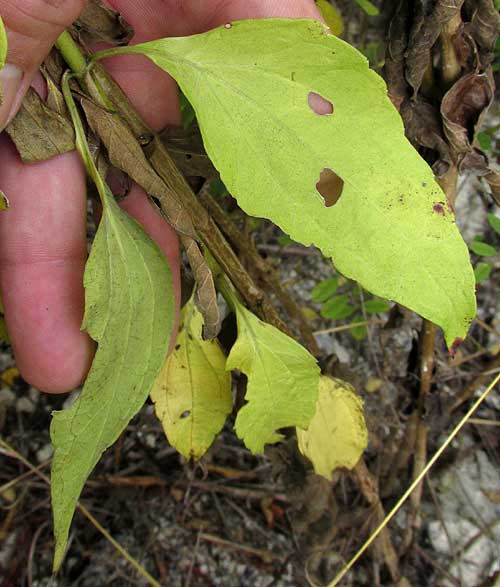Excerpts from Jim Conrad's
Naturalist Newsletter
from the December 28, 2014 Newsletter issued from Río Lagartos, on the Yucatan Peninsula's northern coast (~N21.60°, ~W88.16°), Yucatán state, MÉXICO
CHROMOLAENA
Most days, along the twenty or so miles (30kms) of coastal road just south of Río Lagartos running between San Felipe and Las Coloradas, I go biking for the exercise and just for the pleasure of it. Nowadays along that whole stretch there's just one colony of the bushy, white-topped, Composite Family member, shown below:

The first time I saw this car-size cluster of plants I slammed on the bike's brakes and circled back for a closer look, because the plants' stem-top flowers were busy with the biggest collection of butterflies seen since I've been here. Mostly there were orange Gulf Fritillaries and White Peacocks, but also a few Zebra Heliconians, Monarch-like Soldiers, a dusky Glassy-winged Skipper, and a few others. The plant reminded me of the similar looking Lateflowering Boneset, Eupatorium serotinus, we had back in Texas which similarly attracted hordes of butterflies and whose white blossoms also smelled intensely sweet.
In fact, most North American wildflower fanciers seeing our roadside composite without a blink would assume that it's just another member of the big, commonly encountered, often weedy Eupatorium genus. The flowering heads certainly look like those of Eupatorium, especially with the long, stringy style branches rising above each head, as shown below:

Up closer, however, doubts arise about this being just another Eupatorium, because the greenish bracts composing the urn-shaped involucre surrounding the disc flowers look different from "normal" Eupatorium bracts, as you can see below:

Notice how each bract bears just one strong, green midrib with much smaller, green veins paralleling it for its length, and that the bracts' margins are white and papery. Eupatorium bracts aren't supposed to do that. Still, individual disc flowers removed from a broken-open head look enough like standard Eupatorium flowers, as seen below:

Also, the stems' lower leaves, which arise two to a node (opposite) could belong to any Eupatorium, as shown below:

However, besides the strange bracts, there's one other matter that was visible in the first photo that arouses doubt about this being a Eupatorium. That is, our roadside plant has branching, woody bases. Eupatorium species are perennials, but they seldom branch, and I've never seen one that was genuinely woody like these.
Our roadside butterfly attracter is CHROMOLAENA LAEVIGATA, which early botanists with Eupatorium on their mind called Eupatorium laevigatum. Chromolaena is mostly a tropical American genus and embraces about 165 species found from the southeastern and south-central US south into Brazil, with a center of evolution being in Brazil. Despite our Chromolaena laevigata being one of the most widely spread of the genus, sometimes becoming an aggressive weed, it's little known in English speaking countries. When English speakers refer to it often they just call it Chromolaena. It enjoys many Spanish and Portuguese names, however, one of the most interesting being Purgación, which refers to purification, purging or atonement.
Studies have shown that oils obtained from Chromolaena laevigata show antibacterial action.